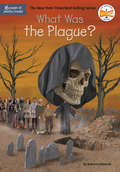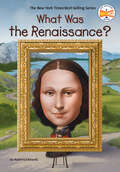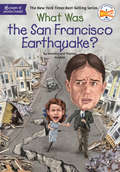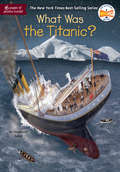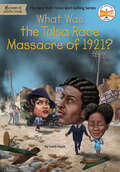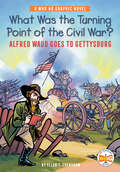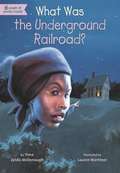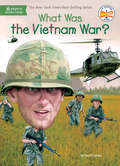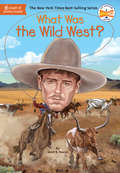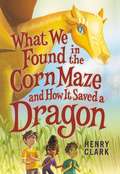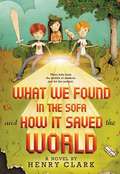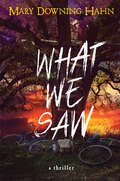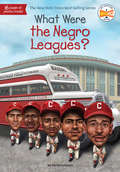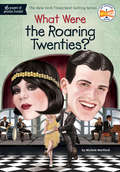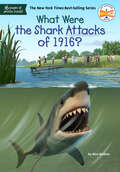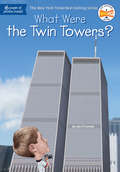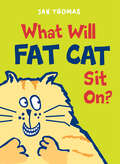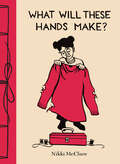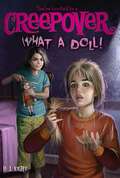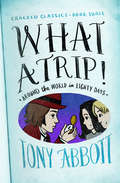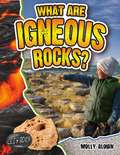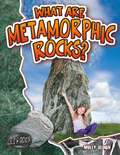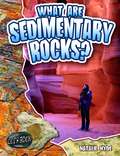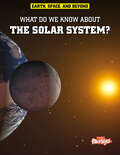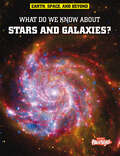- Table View
- List View
What Was the Plague? (What Was?)
by Roberta Edwards Who HQOh, rats! It's time to take a deeper look at what caused the Black Death--the deadliest pandemic recorded in human history.While the coronavirus COVID-19 changed the world in 2020, it still isn't the largest and deadliest pandemic in history. That title is held by the Plague. This disease, also known as the "Black Death," spread throughout Asia, Africa, and Europe in the fourteenth century and claimed an astonishing 50 million lives by the time it officially ended. Author Roberta Edwards takes readers back to these grimy and horrific years, explaining just how this pandemic began, how society reacted to the disease, and the impact it left on the world.With 80 black-and-white illustrations and an engaging 16-page photo insert, readers will be excited to read this latest additon to Who HQ!
What Was the Renaissance? (What Was?)
by Who HQ Roberta EdwardsDiscover all there is to know about the Renaissance, the period in history that took Europe from the Middle Ages to modern times!Beginning in Italy, the Renaissance was a cultural movement that spread throughout Europe and affected art, science, technology, politics, and thought. From the 1300s to the beginning of the 1600s, scholars started to question what they knew and looked to literature and historical texts to develop new ideas for why things were the way they were. In just a short amount of time, the foundations for European life were uprooted and examined, leading people, including Leonardo da Vinci and Michelangelo, to explore new ways of thinking and being. Readers will learn why the Renaissance was such a pivotal time in European history and how it still influences us.
What Was the San Francisco Earthquake? (What Was?)
by Dorothy Hoobler Thomas Hoobler Ted HammondIn this addition to the What Was? series, kids will experience what it was like to be in San Francisco in 1906 when the ground buckled in a major, catastrophic earthquake.One early April morning in 1906, the people of San Francisco were jolted awake by a mammoth earthquake--one that registered 7.8 on the Richter Scale. Not only was there major damage from the quake itself but broken gas lines sparked a fire that ravaged the city for days. More than 500 city blocks were destroyed and over 200,000 people were left homeless. But the city quickly managed to rebuild, rising from the ashes to become the major tourist destination it is today. Here's an exciting recount of an incredible disaster.From the Trade Paperback edition.
What Was the Titanic? (What Was?)
by Gregory Copeland Stephanie Sabol Who HqFor more than 100 years, people have been captivated by the disastrous sinking of the Titanic that claimed over 1,500 lives. Now young readers can find out why the great ship went down and how it was discovered seventy-five years later.At 2:20 a.m. on April 15, 1912, the Royal Mail Steamer Titanic, the largest passenger steamship of this time, met its catastrophic end after crashing into an iceberg. Of the 2,240 passengers and crew onboard, only 705 survived. More than 100 years later, today's readers will be intrigued by the mystery that surrounds this ship that was originally labeled "unsinkable."
What Was the Tulsa Race Massacre of 1921? (What Was?)
by Who HQ Caleb GayleLearn how envy and racism led to the tragic destruction of the thriving Black community in Tulsa, Oklahoma, in this thought-provoking addition to the New York Times bestselling What Was? series!Before May 31, 1921, the Greenwood District of Tulsa, Oklahoma, was a flourishing neighborhood of 10,000 Black residents. There, Black families found success and community. They ran their own businesses, including barbershops, clothing stores, jewelers, restaurants, movie theatres, and more. There also were Black doctors, dentists, and lawyers to serve the neighborhood. Then, in one weekend, all of this was lost. A racist mob tore through the streets, burning everything to the ground and killing scores of innocent residents. Learn about what led to one of the worst moments of racial violence in America's history in this nonfiction book for young readers.
What Was the Turning Point of the Civil War?: A Who HQ Graphic Novel (Who HQ Graphic Novels)
by Who HQ Ellen T. Crenshaw"A nuanced piece of history told simply and well." — Kirkus ReviewsDiscover the story behind the Battle of Gettysburg through the eyes of war reporter Alfred Waud in this compelling graphic novel -- written and illustrated by National Book Award-longlisted creator Ellen T. Crenshaw.Presenting Who HQ Graphic Novels: an exciting new addition to the #1 New York Times Best-Selling Who Was? series!See the Battle of Gettysburg through the eyes Alfred Waud, a special artist and war correspondent whose depiction of Pickett's Charge is thought to be the only visual account by an eyewitness. A story of extreme risk, strife, and the search for truth, this graphic novel invites readers to immerse themselves into the crucial Civil War battle -- brought to life by gripping narrative and vivid full-color illustrations that jump off the page.
What Was the Underground Railroad?
by Yona Zeldis Mcdonough James Bennett Lauren MortimerNo one knows where the term Underground Railroad came from--there were no trains or tracks, only "conductors" who helped escaping slaves to freedom. Including real stories about "passengers" on the "Railroad," this book chronicles slaves' close calls with bounty hunters, exhausting struggles on the road, and what they sacrificed for freedom. With 80 black-and-white illustrations throughout and a sixteen-page black-and-white photo insert, the Underground Railroad comes alive!
What Was the Vietnam War? (What Was?)
by Jim O'Connor Who HQLearn how the United States ended up fighting for twenty years in a remote country on the other side of the world.The Vietnam War was as much a part of the tumultuous Sixties as Flower Power and the Civil Rights Movement. Five US presidents were convinced that American troops could end a war in the small, divided country of Vietnam and stop Communism from spreading in Southeast Asia. But they were wrong, and the result was the death of 58,000 American troops. Presenting all sides of a complicated and tragic chapter in recent history, Jim O'Connor explains why the US got involved, what the human cost was, and how defeat in Vietnam left a lasting scar on America.
What Was the Wild West? (What Was?)
by Janet B. Pascal Stephen MarchesiSaddle up and get ready for a ride back into the wild and wooly past of the American West.The west was at its wildest from 1865 to 1895, when territories west of the Mississippi River remained untamed and lawless. Famous for cowboys, American Indians, lawmen, gunslingers, pioneers, and prospectors, this period in US history captures the imagination of all kids and now is brought vividly to life.From the Trade Paperback edition.
What We Found in the Corn Maze and How It Saved a Dragon
by Henry ClarkWhen three kids discover a book of magic spells that can only be cast during a few short minutes a day, they'll need all the time they can get to save a dying magical world, its last dragon, and themselves.An ordinary day turns extraordinary when twelve-year-old Cal witnesses his neighbor Modesty summon a slew of lost coins without lifting a finger. Turns out she has a secret manual of magic spells . . . but they only work sometimes. And they're the most boring spells ever: To Change the Color of a Room, To Repair a Chimney, To Walk With Stilts, To Untangle Yarn. Useless!But when Cal, his friend Drew, and Modesty are suddenly transported to the world the spells come from -- a world that's about to lose its last dragon -- they'll have to find a way to use the oddly specific incantations to save the day, if only they can figure out when magic works.From the inventive mind of Henry Clark comes a hilariously wacky adventure about magic, friendship, a lookout tower come to life, a maze in the shape of a dragon, an actual dragon named Phlogiston, and lots and lots of popcorn.
What We Found in the Sofa and How It Saved the World
by Henry ClarkThe adventure of a lifetime begins between two sofa cushions....When River, Freak, and Fiona discover a mysterious sofa sitting at their bus stop, their search for loose change produces a rare zucchini-colored crayon. Little do they know this peculiar treasure is about to launch them into the middle of a plot to conquer the world!The kids' only hope is to trap the plot's mastermind when he comes to steal the crayon. But how can three kids from the middle of nowhere stop an evil billionaire? With the help of an eccentric neighbor, an artificially intelligent domino, a DNA-analyzing tray, two hot air balloons, and a cat named Mucus, they just might be able to save the planet.This clever comic adventure from debut author Henry Clark is a truly original and utterly wacky story about the importance of intelligence and curiosity in a complacent world.
What We Saw: A Thriller
by Mary Downing HahnA chilling murder mystery lies at the heart of this page-turning thriller about a missing teacher, small town secrets, and turbulent tween friendships from master of middle grade horror Mary Downing Hahn.When best friends Abbi and Skylar witness a clandestine meeting between a mysterious woman and someone in a dark van, they're thrilled. Finally, a mystery to spice up the summer!Who could these people be? Why are they meeting? Are they spies? Criminals? The two girls are determined to find out. But then a local woman goes missing and is found dead in the woods. And Abbi and Skylar realize that their detective work could hold the keys to solving her murder. Suddenly, sleuthing isn't so fun anymore.As tensions rise and their friendship frays, the girls find themselves in increasing danger, and must choose between keeping a secret or exposing a life-altering truth.
What Were the Negro Leagues? (What Was?)
by Varian Johnson Who HQThis baseball league that was made up of African American players and run by African American owners ushered in the biggest change in the history of baseball. In America during the early twentieth century, no part was safe from segregation, not even the country's national pastime, baseball. Despite their exodus from the Major Leagues because of the color of their skin, African American men still found a way to participate in the sport they loved. Author Varian Johnson shines a spotlight on the players, coaches, owners, and teams that dominated the Negro Leagues during the 1930s and 40s. Readers will learn about how phenomenal players like Satchel Paige, Josh Gibson, and of course, Jackie Robinson greatly changed the sport of baseball.
What Were the Roaring Twenties? (What Was?)
by Who Hq Jake Murray Michele MortlockFlappers, flag-pole sitting, and the Ford Model T--these are just a few of the things that instantly conjure up a unique era--the Roaring Twenties.It was the bees' knees, the cat's meow. If you're not familiar with 1920s slang, all the more reason to read this fascinating look at that wild, exciting decade. It began on the heels of one tragedy--the flu pandemic of 1918--and ended with another: the start of the Great Depression. But in between there were plenty of good times--the Model T cars that Henry Ford made were cheap enough for the masses, the new sound of jazz heated up speakeasies and nightclubs during the time of Prohibition. Women, recently given the right to vote, cut their long hair into bobs, wore short skirts and makeup, and danced the Charleston (sometimes in marathons that lasted days). Michele Mortlock hits all the highlights of this heady age that still feels modern even a hundred years later.
What Were the Shark Attacks of 1916? (What Was?)
by Nico Medina Who HQThe panic-filled summer of 1916, when multiple deadly shark attacks shocked the nation, is chronicled in this gripping addition to the New York Times Best-Selling What Was? series.On July 1, 1916, witnesses watched in horror as twenty-eight-year-old Charles Vansant was attacked and killed by a shark in shallow water off Beach Haven, New Jersey—the first recorded shark attack in American history. Scientists claimed a shark could not be responsible, but more deadly attacks soon followed along the Jersey Shore and up the freshwater Matawan Creek, setting off a nationwide panic that led the White House to declare a &“War on Sharks.&” In this illustrated book, which features 16 pages of black-and-white photographs, readers will learn about the likely culprit (or culprits) in the attacks—the great white shark and the bull shark—and how the bloody summer of 1916 would change how people viewed sharks forever.
What Were the Twin Towers? (What Was?)
by Jim O'Connor Ted Hammond Kevin McveighDiscover the true story of the Twin Towers--how they came to be the tallest buildings in the world and why they were destroyed.When the Twin Towers were built in 1973, they were billed as an architectural wonder. At 1,368 feet, they clocked in as the tallest buildings in the world and changed the New York City skyline dramatically. Offices and corporations moved into the towers--also known as the World Trade Center--and the buildings were seen as the economic hub of the world. But on September 11, 2001, a terrorist attack toppled the towers and changed our nation forever. Discover the whole story of the Twin Towers--from their ambitious construction to their tragic end.
What Will Fat Cat Sit On? (The Giggle Gang)
by Jan ThomasThis &“rollicking&” picture book is &“laugh-out-loud&” fun for new readers (Publishers Weekly, starred review).What will Fat Cat sit on? The pig? (Oink!) The chicken? (Cluck!) How about the dog? (Grrrr.) Everyone in this bumbling animal gang—understandably—hopes the victim will be someone else! Leave it to Mouse to come up with a brilliant solution that satisfies everyone, even Fat Cat himself.Filled with hilarious asides and an interactive question-answer format, this irreverent picture book will delight little ones who love to shout &“NO!&”&“Fun to read aloud, it would also make an effective early reader for preschoolers.&”—The New York Times Book Review &“A cat that puts Garfield to shame…a lot of laughs. This is a book that toddlers and new readers will reach for again and again.&”—Kirkus Reviews
What Will These Hands Make?
by Nikki McClure“Themes of community, creativity, and craft are at the heart of this book about a family preparing for a grandmother’s birthday celebration.” —School Library JournalThis lyrical picture book from beloved creator Nikki McClure follows a family through one day and muses in the possibilities that one day holds—from enjoying treats at the bakery, to admiring handmade goods from local artisan shops, to observing the new construction in town. Illuminating themes of community, creativity, and collaboration, What Will These Hands Make? dares the reader to dream up everything they can be and all the ways they can leave their little corner of the world better than they found it.“Capitalized headers boldly ask “WILL THESE HANDS MAKE,” with possibilities unfurling in lyrical, lucid verse beneath. Awe-inspiring double-page spreads show a busy town from multiple, miraculous perspectives . . . Extraordinary artwork inspires young people to use their hearts and hands.” —Kirkus Reviews (starred review)“This celebration of citizenry and craft is a poignant reminder of the objects and places that makers weave . . . The book’s appeal spans a wide range: younger readers will enjoy the seek-and-find aspect, and older readers may find inspiration in its vision of daily life and communal innovation.” —Publishers Weekly (starred review)“Careful viewers will be delighted to find scenes revisited in closer detail and from different vantage points . . . The clever bookmaking technique, which moves between the busy scene and its individual sections, produces the joy of a shared experience in which all hands combine.” —Booklist
What a Doll! (You're Invited to a Creepover #12)
by P.J. NightEmmy&’s new doll has strange powers over her best friend in this entrancing addition to the You&’re Invited to a Creepover series.Emmy Spencer and Lizzy Draper have been best friends since birth, but now that they&’re in seventh grade, they&’ve begun to drift apart. Lizzy—insistent on being called Liz now—has a new group of friends, and she has gone out of her way to exclude Emmy from them. It&’s almost as if Lizzy doesn&’t want Emmy hanging out with her anymore. But then Emmy comes into possession of a doll that can change all that—a doll that will put Emmy in control of Lizzy&’s every move. Can she use the doll to save their friendship, or will it end up controlling them both? This spooky tale is a level 3 on the Creep-o-Meter.
What a Trip!: (Around the World in Eighty Days) (Cracked Classics #3)
by Tony Abbott&“A treat for reluctant readers,&” as two sixth graders discover, when you can travel into books, going around the world is easy (School Library Journal). Middle schoolers Devin and Frankie—short for Francine—have found a unique shortcut to passing English. When their teacher gives them a book to read, they just toss it through the magic metal detector in their school library, which transports them into the world of the novel, allowing them to live the book firsthand and always get an A. The system works great until the librarian hires a repairman to fix what the kids call the &“zapper gates.&” While trying to distract him, Devin and Frankie drop a book through the detector, and find themselves on a whirlwind tour of the globe in Jules Verne&’s classic adventure. In the company of mad explorer Phileas Fogg, Devin and Frankie embark on a round-the-world journey by train, ship, and hot air balloon. But they&’ll have to race to beat the clock, or risk getting stuck in the book forever. As with other books in Tony Abbott&’s Cracked Classics series, &“the message that reading is important and can be fun comes through loud and clear. The short chapters make this an ideal read-aloud and a treat for reluctant readers&” (School Library Journal).
What are Igneous Rocks?
by Molly AloianIgneous rock has a dramatic beginning--it requires red-hot volcanic activity. This fact-filled book explains how granite, lava, basalt, silica, quartz and feldspar are formed after hot, molten rock cools. Readers will also learn about volcanoes and tectonic plates, the minerals that make up igneous rocks, and the crystallization of rock material.
What are Metamorphic Rocks?
by Molly AloianThe science of rocks is fascinating! This rock-solid series looks at the characteristics of different types of rocks-igneous, sedimentary, and metamorphic-describing everything from their mineral components to their color, and whether or not they contain fossils.
What are Sedimentary Rocks?
by Natalie HydeThe science of rocks is fascinating! This rock-solid series looks at the characteristics of different types of rocks-igneous, sedimentary, and metamorphic-describing everything from their mineral components to their color, and whether or not they contain fossils.
